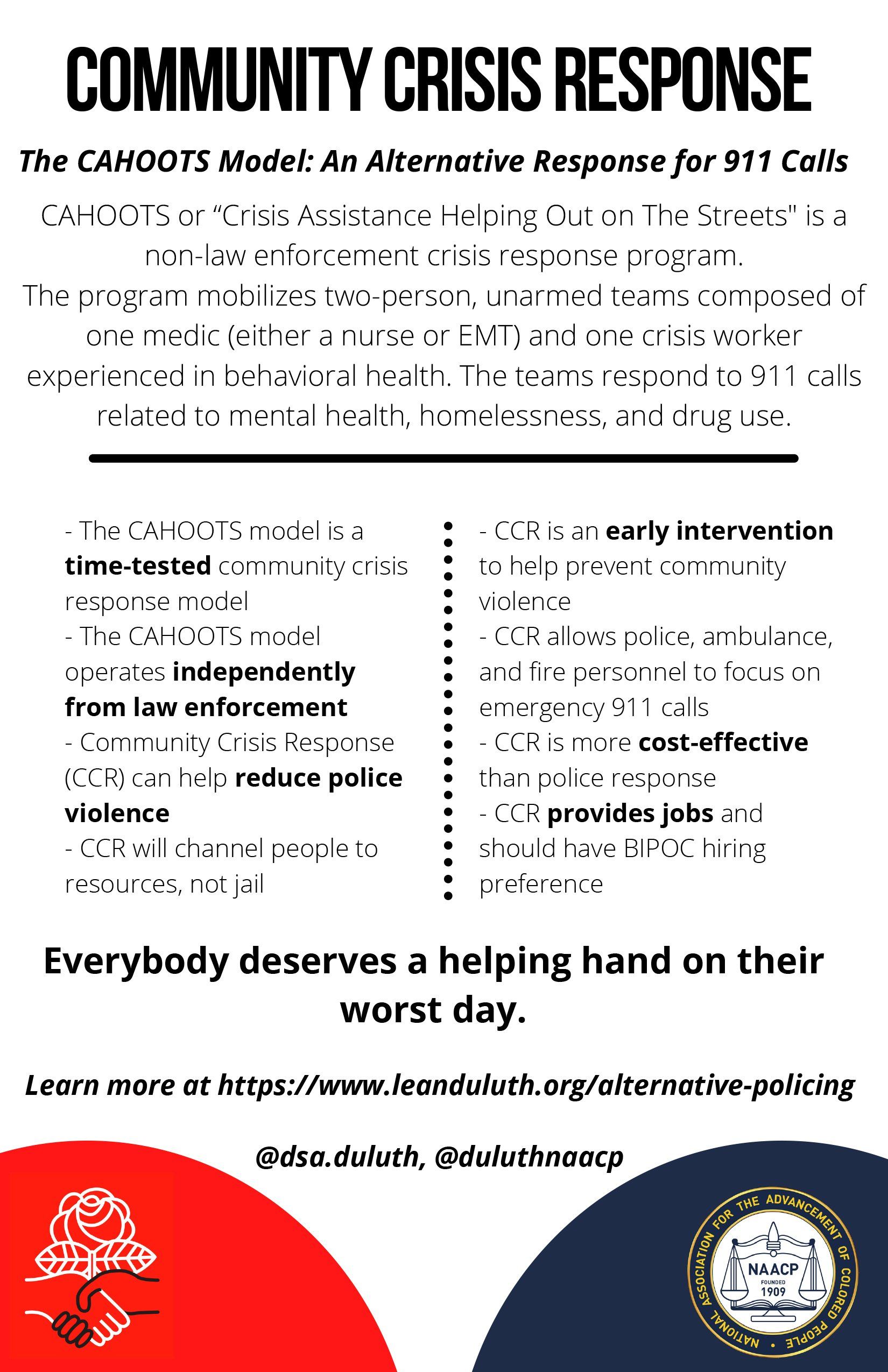If you're experiencing a crisis,
CALL 988.
The Human Development Center (HDC) has implemented a community crisis response program aimed at diverting non-violent emergency calls from the police to mental health professionals. HDC writes about their program:
The Mobile Crisis Response team serves Duluth and the 30-mile surrounding radius. These teams provide fast, unarmed responses meant to intervene, de-escalate, stabilize, and assess our community members experiencing crisis. We continue to successfully provide services that divert from law enforcement and emergency department involvement while connecting people with outpatient services, rapid access Psychiatry, peer support, substance use and addiction services, supportive counseling, skills training, and more.
Duluth's community crisis response program is ongoing. The folowing information summarizes the original community demands for this process.
#911forEveryone
#ASaferPublicSafety
What does a compassionate & effective public safety response to mental health, housing, and substance abuse crises look like to us?
- A comprehensive and integrated crisis response service that will make it possible for everyone in Duluth to receive proper care from experienced responders with specific training to deescalate emergencies
- 24/7 availability
- A service that makes people feel safe and empowers them during their worst days, without the fear of being taken to jail or the emergency department
- We are negotiating with power holders to ensure that the new service would have:
- Community-based leadership in order to ensure that the new service meets the needs of all community members, including oppressed communities
- Representative hiring practices with priority given to hiring BIPOC crisis responders
- Non-punitive response that is separate from the police & fire departments, but integrated into these response services when necessary
- Ability to be dispatched from 911 and a separate crisis line

Who has been working on the issue here in Duluth?
- Community organizers from the Twin Ports Democratic Socialists of America (DSA), the NAACP, and the Duluth Community Safety Initiative (DCSI) have been working with the city and county throughout 2021 to develop a plan for alternative crisis response in the area.
- Discussions with the Human Development Center (HDC), the nonprofit awarded county funds for 2022 crisis response services, have led to the planning of a new program. HDC has signed on to demands for ongoing community oversight and involvement in the process, including a community advisory council which would oversee and help to advocate for the community’s interests in this budding program.
- A collaborative hiring process for crisis response workers and a community coordinator position is underway.
How will resources flow from the city to somebody experiencing a crisis?

Have similar programs like this been successful around the country?
The CAHOOTS Model as a First Response to 911 Calls
A number of cities across the country are in the process of developing civilian first-responder programs for their communities. One well known example of a civilian based program is
CAHOOTS, or
“Crisis Assistance Helping Out on The Streets,” which has been running successfully for over 30 years in Eugene, Oregon. While other types of crisis response are more embedded in their local police department and government, the CAHOOTS-model stresses the importance of offering non law-enforcement, independent crisis response teams. and urges that similar programs be operated by a separate community-led organization or local non-profit. As they demonstrate, this model offers not only
decreased police violence and vital help for those who need it, but also
considerable economic benefits for its home city. By offering an option for non-police and non-ambulance crisis response, CAHOOTS
saves an average of $8 million on public safety and $14 million on ambulance/emergency room treatment annually. As an official part of the Eugene emergency response system, the program handled 24,000 calls (around 20% of the calls dispatched by 911) in 2019. CAHOOTS is a concrete example of a successful program with more than 30 years of experience and impressive results.
How Does it Work?
Instead of sending police out to every 911 call, teams comprised of one medic (either a nurse or EMT) and one crisis worker experienced in behavioral health are sent to respond to mental health, homelessness, and drug use crises. These unarmed teams are intensively trained in emergency medical services and trauma-informed de-escalation techniques. For an overwhelming majority of cases these tools were all that were needed. 0f the 24,000 calls CAHOOTS responded to in 2019, police were only contacted for further assistance 150 times - less than 1% of all calls.
Why is it Necessary?
Adding an independent crisis intervention program to our local emergency response system can play a huge role in decreasing the risk of police violence. A 2015 study found that
those with untreated mental illness account for at least 25%—and perhaps as many as 50%—of all fatal police shootings.
The researchers concluded: “Given the prevalence of mental illness in police shootings, reducing encounters between on-duty law enforcement and individuals with the most severe psychiatric diseases may represent the single most immediate, practical strategy for reducing fatal police shootings in the United States.”⁴ Furthermore, a recent local petition created in the aftermath of George Floyd’s murder (which has garnered over 3,000 signatures from Duluth area residents) has urged local “investment in community-led health and safety strategies.” The CAHOOTS program is a time-tested, demonstrably successful example of such a strategy.
Sources
Thompson, Christie. “This City Stopped Sending Police to Every 911 Call.” The Daily Beast, July 24, 2020. https://news.yahoo.com/city-stopped-sending-police-every-074848097.html
Andrew, Scottie. “This town of 170,000 replaced some cops with medics and mental health workers. It's worked for over 30 years” CNN. July 5, 2020. https://www.cnn.com/2020/07/05/us/cahoots-replace-police-mental-health-trnd/index.html
CAHOOTS Media Guide, https://whitebirdclinic.org/wp-content/uploads/2020/06/CAHOOTS-Media-Guide-20200626.pdf
Office of Research and Public Affairs, “Overlooked in the Undercounted: The Role of Mental Illness in Fatal Law Enforcement Encounters,” Dec., 2015, https://www.treatmentadvocacycenter.org/storage/documents/overlooked-in-the-undercounted.pdf